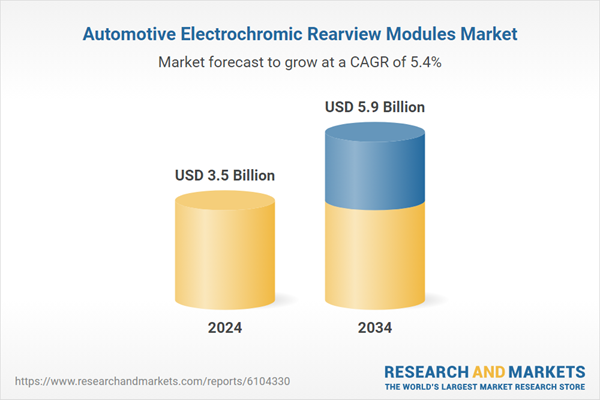Beyond just dimming capabilities, these modules are evolving into multifunctional systems integrated with intelligent driving technologies. Modern rearview mirrors are no longer passive glass units - they now operate as part of a vehicle’s digital ecosystem. Many feature embedded displays, smart sensors, rearview cameras, and support for advanced driver-assistance systems. These integrations enable a more seamless and connected driving experience.
Automakers are increasingly embedding this technology into both premium and mid-range models to enhance the in-cabin experience and differentiate themselves in an intensely competitive market. As the cost of manufacturing decreases and the benefits become more evident, the demand for intelligent rearview modules is expected to surge across a wider range of vehicle types.
In terms of product segmentation, the market includes interior electrochromic rearview mirrors, exterior (side) electrochromic mirrors, and integrated rearview modules featuring displays and sensors. Among these, the interior electrochromic rearview mirror segment held the largest share in 2024, accounting for approximately 50% of the global market. This segment is also anticipated to grow at a CAGR of over 6.2% during the forecast period. The growing emphasis on driver comfort and the elimination of rear glare has pushed automakers to prioritize interior mirrors that can automatically adapt to ambient lighting. Their integration with digital systems has further boosted adoption, particularly in vehicles positioned between mid-range and high-end categories.
When categorized by vehicle type, the automotive electrochromic rearview modules market is divided into passenger cars, commercial vehicles, and electric vehicles. Passenger cars emerged as the dominant segment in 2024, capturing nearly 60% of the total market share. This dominance is underpinned by the rising popularity of comfort and safety enhancements in private vehicles.
As technological innovations continue to trickle down from luxury cars to mass-market models, rearview mirrors with glare-reducing capabilities are becoming standard features. These mirrors are increasingly recognized for their contribution to reducing driver fatigue and improving road visibility, especially during nighttime and in urban traffic environments.
By technology, the market is segmented into gel-based, solid-state, and nanomaterial-based electrochromic mirrors. The gel-based segment led the market in 2024 and continues to hold a strong position due to its balance of reliability, performance, and cost-efficiency. These mirrors offer consistent tinting transitions and are easier to produce, making them highly suitable for mid-range vehicles that prioritize affordability without compromising safety and functionality. Their strong adaptability and proven track record make them a favored choice among automakers aiming to enhance vehicle performance at a lower cost.
The market is also segmented based on sales channels into OEM and aftermarket. In 2024, the OEM segment was the clear leader, driven by the increased integration of advanced mirror systems directly into vehicle manufacturing. Original equipment manufacturers offer better product alignment, performance, and reliability, which are essential when safety-critical components like rearview mirrors are involved. Automakers increasingly rely on OEMs to ensure seamless integration with a vehicle’s digital systems, reinforcing OEMs as the preferred channel.
Regionally, the United States led the global automotive electrochromic rearview modules market in 2024, generating around USD 1.21 billion and accounting for approximately 84% of the global market share. This dominance is fueled by high adoption rates of automotive innovations and a strong market for feature-rich vehicles. The growing consumer interest in in-cabin enhancements and regulatory emphasis on road safety continues to support robust demand across the country.
Industry players are ramping up efforts to innovate in areas like faster-reacting dimming technology, display-enhanced mirrors, and enhanced integration with ADAS platforms. Strategic manufacturing and R&D expansion in major automotive regions, including North America, Europe, and Asia, is becoming increasingly important for staying competitive. Proximity to vehicle assembly units allows manufacturers to quickly adapt to shifting market demands and shorten product development cycles. As this sector matures, suppliers and automakers alike are prioritizing tighter collaboration to meet evolving performance expectations, design trends, and safety standards.
Comprehensive Market Analysis and Forecast
- Industry trends, key growth drivers, challenges, future opportunities, and regulatory landscape
- Competitive landscape with Porter’s Five Forces and PESTEL analysis
- Market size, segmentation, and regional forecasts
- In-depth company profiles, business strategies, financial insights, and SWOT analysis
This product will be delivered within 2-4 business days.
Table of Contents
COMPANIES MENTIONED
The companies featured in this automotive electrochromic rearview modules market report include:- Burco
- CIPA
- Ficosa
- FLABEG
- Gentex
- Honda Lock
- Ichikoh
- Konview
- Magna
- Mitsuba
- Murakami
- Samvardhana Motherson
- Shenzhen Germid
- SL
- Tokai Rika
Table Information
| Report Attribute | Details |
|---|---|
| No. of Pages | 170 |
| Published | June 2025 |
| Forecast Period | 2024 - 2034 |
| Estimated Market Value ( USD | $ 3.5 Billion |
| Forecasted Market Value ( USD | $ 5.9 Billion |
| Compound Annual Growth Rate | 5.4% |
| Regions Covered | Global |
| No. of Companies Mentioned | 16 |









